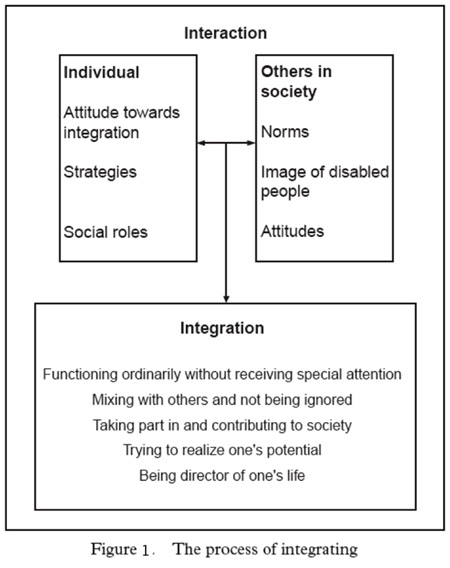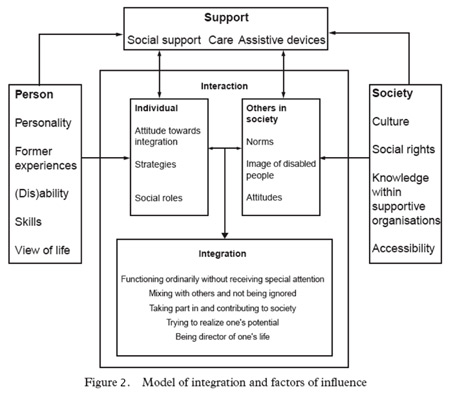

Volume:3, Issue: 1
Mar. 1, 2011


Mar. 1, 2011
DESCRIPTORS: the concept of disability, community integration, UN Convention on the Rights of Persons with Disabilities, Eugenics movement, a model of integration.
SYNOPSIS: The purpose of this paper is to examine the relationship between societal attitudes and policies about people with disabilities and how they impact the ability of people with disabilities to participate fully in society. The author presents a short historic overview and a full model of integration with support services.
***
On March 30, 2007 the United Nations held a signature ceremony for the recently passed United Nations Convention on the Rights of Persons with Disabilities which had been previously passed by the UN General Assembly in December of 2006. The convention is the outcome of many years of work by the UNESCO Ad Hoc Committee on a Comprehensive and Integral International Convention on the Protection and Promotion of the Rights and Dignity of Persons with Disabilities. The overall purpose of the convention is
“… to promote, protect and ensure the full and equal enjoyment of all human rights and fundamental freedoms by all persons with disabilities, and to promote respect for their inherent dignity.”
Among other things, the convention calls for attitudinal and policy changes that will allow those with disabilities to experience the full ebb of societal life to include community living, family participation, work and recreation, and many other aspects of life. The convention is a comprehensive document that recognizes that the vast majority of people with disabilities continue to experience significant hardships as result of societal attitudes toward those with disabilities.
Persons with disabilities have not always experienced such protection of basic “human rights and fundamental freedoms”, a fact stated as one of the concerns listed in the preamble to the convention.
“… persons with disabilities continue to face barriers in their participation as equal members of society and violations of their human rights in all parts of the world.”
Throughout the history of the world individuals with disabilities have experienced neglect and abuse, and severe segregation. And while there have certainly been some improvements in some parts of the world, continued mistreatment continues to be widespread.
As the preamble of the convention points out, “ …disability is an evolving concept and that disability results from the interaction between persons with impairments and attitudinal and environmental barriers that hinders their full and effective participation in society on an equal basis with others.” This idea of disability as an evolving concept is an important idea that emphasizes the need for new ideas about people with disabilities. Without a shift in attitudes towards those with disabilities, it is unlikely that the rights and opportunities will see much change in many parts of the world.
Those with disabilities and their advocates stress the need to overcome traditional perceptions of people with disabilities as objects of charity or sick people that need to be cured, or worse, undesirable societal elements that need to be either segregated from the mainstream or even eliminated. Instead, more progressive ideas about disability reflected in the United Nations convention call for the integration of people with disabilities as full members of society.
However, as the United Nation convention suggests, people with disabilities are often prevented from becoming fully participating members of their communities because of attitudinal, architectural, and social barriers.
A brief history of the treatment of individuals with disabilities in North America is helpful in illustrating the relationship between beliefs and attitudes, and the quality of life for individuals with disabilities. In discussing the treatment of persons with mental retardation in the United States, MacMillan (1982) identifies four distinct historical stages – early history, initial treatment (institutions), the Eugenics movement, and the protection of the rights for those with disabilities.
Early History
The early history period was influenced by superstition and misunderstanding of disabilities and it was common for those with significant disabilities to be viewed as not truly human or in some cases to be possessed by demons. For example, Kanner (1964) in relating an account where Martin Luther, one of the great protestant reformers, suggested that a 12-year old child with a disability should be drowned, states that “ He was firmly of the opinion that such changelings were merely a mass of flesh, a massa carnis, with no soul. For it is in the Devil’s power, that he corrupts people who have reason and souls when he possesses them. The devil sits in such changelings where their souls should have been! (p.7)”
During this period, individuals with significant disabilities were susceptible to severe forms of neglect, exploitation, and abuse with some incidences of compassion and care from religious institutions.
Period of Initial Treatments (and Institutions)
During the 19th century there was a significant move in the United States to create treatment facilities for individuals with disabilities, in the belief that such combined hospitals and schools, as they were often called, could provide the kind treatment and education that would allow individuals to be cured and educated, and eventually move into communities as productive members of society. The movement was largely driven by the initial work of Jean Itard, a French philosopher and physician who had been significantly influenced by the enlightenment thoughts of Locke. As a matter of fact many writings on the history of special education in the US and Europe trace the beginnings to Itard’s educational efforts with Victor (Wild Boy of Aveyron), a child with significant disabilities that had been found abandoned in the forests outside of Paris.
The initial optimism with which these hospital and schools were created soon faded when goals for cures and rehabilitation were not achieved. As a result the goal for these institutions quickly shifted from one where the ultimate goal of societal integration shifted to the idea that these schools were permanent residential placements where individuals could be housed and maintained. Unfortunately, for a variety of reasons including overcrowding, poorly trained staff, and under funding the treatment and living conditions soon deteriorated.
Eugenics Movement
Towards the end of the 19th and beginning of the 20th century, a number of reports were published that suggested a relationship between disabilities and various social problems such as promiscuity, prostitution, illegitimate births, alcoholism, and criminal activity (see for example Goddard’s (1912) report on the Kallikaks). These reports led to policies that encouraged the isolation of individuals with disabilities in institutions as being best for both those with disabilities and as a way to protect society from the possible negative influence of “feeblemindedness”. The use of sterilization became common practice as a way to further protect society.
Protection of the Rights of People with Disabilities
It was only in the 1950’s and 1960’s that a movement began that challenged the popular notion that people with disabilities were best cared for in isolated settings and that is was best that those with disabilities were not part of societal mainstream. Led by organizations such as the Association for Retarded Children (ARC), the notion that people with disabilities could not (or should not) participate in the mainstream of community started to be challenged. By the beginning of this period there was already a widely held belief that individuals with disabilities were much better off segregated in institutional settings where they could be with others like themselves, be taken care of, and receive the kind of education and treatment that met their needs.
Among others, three events led to the decline of institutions and movement towards community based programs for individuals with disabilities. The first was series of court cases in which it was determined that people with disabilities residing in institutions were not receiving the type of services needed. This was judged to be violation of their constitutional rights. Second, reports that described deplorable conditions in institutions. And third, the introduction of the principle of normalization that posited that individuals with disabilities have the right to experience the full ebb of life experiences available to those without disabilities.
Taken together, the three events have led to a steady shift from institutional living for people with disabilities to greater access to community based living options such as group homes, foster care, supported independent living, and other options. At the same time there have been increasing opportunities for individuals to participate in community based work, access community transportation, engage in recreational activities, and other normalized events. The concept of normalization has slowly evolved to include the concept of choice for people with disabilities and is now commonly referred to ask “social role valorization”.
Unfortunately, UNESCO reports suggest that in much of the developed world individuals with disabilities continue to experience significant neglect and isolation. The UN Convention is an attempt to call the world to consistent integration of people with disabilities into all aspects of society.
Integration: What does it look like?
The passing of the UN Convention on disabilities is an important step toward the integration of individuals with disabilities, calling for the full participation of people in all aspects of societal living. However, some experts in the field of societal integration suggest that the concept of integration is not well defined (e.g. van de Ven, Post, de Witte, & van den Heuvel, 2005). As a matter of fact van de Ven (2005) suggests that earlier iterations of integration required that while people with disabilities should be afforded the opportunity to participate in societal living, they needed to be able to “adapt” to the norms and values of the community. In the 1950’s and 1960’s those who were not able to do so would continue to be isolated and marginalized.
Van de Ven (2005) presents a three step model of integration to include integration component outcomes, the integration process, and factors that influence integration:
a. Integration Outcomes
When integration works well, the person with a disability is able to function completely in society as others would. Ideally this would mean that five elements would be present.
Successful integration requires interaction between those with disabilities and others in society whereby more positive images of disabled people and attitudes toward integration are formed. According to van de Ven (2005) it is when those with disabilities are willing to pursue strategies of taking on socially validated roles in communities that the beliefs about disabilities and attitudes begin to change. This interaction is illustrated in the following figure.

Finally, van de Ven describes three kinds of factors that influence the process of integration: personal factors in the person with the disability, societal factors, and support system factors. Personal factors include such things as personality, past experiences, disability, and current skills.
Societal factors include such things as societal knowledge of people with disabilities, social rights available such as financial support, and accessibility issues such building access. The nature of these societal factors will determine to a large extent whether or not there will be barriers to integration.
Finally, the existence of support factors such as professional services and assistive devices contribute to successful integration. By definition, people with disabilities will always need some degree and some level of support service. The full model of integration with support services is presented in the following figure.

Summary
The UN Convention is an important step towards the protection, valuing, and integration of all persons with disabilities in all societies. However, if the goals outlined in the convention are to be achieved it will be necessary to envision a view of disability and societal participation that differs significantly from those that have existed in the past and continue to dominate in many parts of the world today. Such a change will require a process whereby a society’s understanding of people with disabilities evolves from one of fear and isolation, to one where those with disabilities are valued and welcomed as fully participating members of our communities.
This paper included a brief summary of how the concept of disability has changed during the last 200 or so years in the United States and Europe. And while there is yet much progress to be made, people with disabilities in Europe and the United States have achieved significant levels of community integration. Let’s hope that it will not take that long for other parts of the world to achieve similar levels of societal integration.
The process of integration model presented in the latter part of the paper can help as we answer three important questions – what do we want integration to look like, how does the process of integration happen, and what are the supports that are necessary to make integration happen. An understanding and implementation of this model may be useful as communities consider how to best move toward the inclusion of people with disabilities.
References
Goddard, H. H. (1912). The Kalikak family: A study in the heredity of mental retardation. New York, NY: Macmillan.
Kanner, L. (1964). A History of the care of the mentally retarded. Springfield, IL: Thomas, 1964.
MacMillan, D. L. (1982). Mental Retardation in School and Society, 2nd Ed. Boston, MA: Little, Brown, and Co.
van de Ven, L., Post, M., de Witte, L., & van den Heuvel, W. (2005). It takes two to tango: the integration of people with disabilities into society. Disability & Society, 20(3), 311-329.
Wolfensberger W(2000). A brief overview of Social Role Valorization. Mental Retardation. 38,105-123.
1 Eigenbrood, Rick – Dean, School of Education, Seattle Pacific University, Seattle, WA, USA.

Home | Copyright © 2025, Russian-American Education Forum